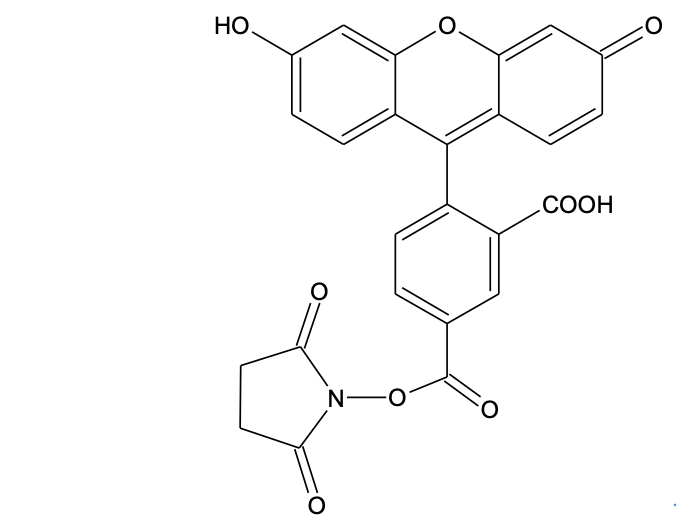Fluorescent Dye Carboxylic Acids and Their Succinimidyl Esters
Succinimidyl esters are proven to be the best reagents for amine modifications because the amide bonds that are formed are essentially identical to, and as stable as the natural peptide bonds. These reagents are generally stable and show good reactivity and selectivity with aliphatic amines. There are few factors that need be considered when SE compounds are used for conjugation reaction:
1). Solvents:For the most part, reactive dyes are hydrophobic molecules and should be dissolved in anhydrous dimethylformamide (DMF) or dimethylsulfoxide (DMSO).
2). Reaction pH:The labeling reactions of amines with succinimidyl esters are strongly pH dependent. Amine-reactive reagents react with non-protonated aliphatic amine groups, including the terminal amines of proteins and the e-amino groups of lysines. Thus amine acylation reactions are usually carried out above pH 7.5. Protein modifications by succinimidyl esters can typically be done at pH 7.5-8.5, whereas isothiocyanates may require a pH 9.0-10.0 for optimal conjugations.
3).Reaction Buffers:Buffers that contain free amines such as Tris and glycine and thiol compounds must be avoided when using an amine-reactive reagent. Ammonium salts (such as ammonium sulfate and ammonium acetate) that are widely used for protein precipitation must also be removed (such as viadinlysis) before performing dye conjugations.
4). Reaction Temperature:Most conjugations are done at room temperature. However, either elevated or reduced temperature may be required for a particular labeling reaction.
5-FAM, SE [5-Carboxyfluorescein, succinimidyl ester]
| Features and Biological Applications5-FAM, SE is the amine-reactive succinimidyl ester of single isomer 5-FAM acid. It is one of the most popular green fluorescent reagents used for labeling peptides, proteins and nucleotides. It has also been used to prepare various small fluorescent molecules.
|
References
1. Sakamoto M, et al.(2003). Application of terminal RFLP analysis to characterize oral bacterial flora in saliva of healthy subjects and patients with periodontitis. J Med Microbiol52, 79-89.
2. Hahn M, et al. (2001). Influence of fluorophore dye labels on the migration behavior of polymerase chain reaction-amplified short tandem repeats during denaturing capillary electrophoresis. Electrophoresis22, 2691-700.
3. Araie, M., Carboxyfluorescein. A dye for evaluating the corneal endothelial barrier function in vivo.Exp Eye Res1986, 42, 141-50.
NOTE: Always wear lab coats, gloves and goggles when working with our products although they are low-risk chemicals for R&D only.
| Name | 5-FAM, SE [5-Carboxyfluorescein, succinimidyl ester] | ||
|---|---|---|---|
| CAT# | 113-100 mg,113-1g | CAS# | 92557-80-7 |
| Storage# | Refrigerated & desiccated | Shelf Life# | 12 months |
| Ex(nm)# | 492 | Em(nm)# | 518 |
| MW# | 473.39 | Solvent# | DMSO/DMF |
| Name | 5-FAM, SE [5-Carboxyfluorescein, succinimidyl ester] |
|---|---|
| CAT# | 113-100 mg,113-1g |
| CAS# | 92557-80-7 |
| Storage# | Refrigerated & desiccated |
| Shelf Life# | 12 months |
| Ex(nm)# | 492 |
| Em(nm)# | 518 |
| MW# | 473.39 |
| Solvent# | DMSO/DMF |


![5-FAM, SE [5-Carboxyfluorescein, succinimidyl ester]详细说明书](/en/Public/Home/images/pic52.png) Specification
Specification![5-FAM, SE [5-Carboxyfluorescein, succinimidyl ester]技术资料](/en/Public/Home/images/pic53.png) Support
Support




